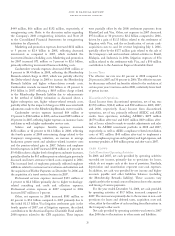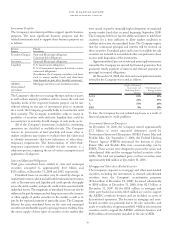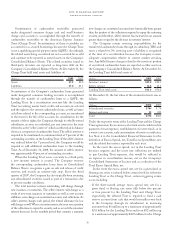American Express 2008 Annual Report Download - page 35
Download and view the complete annual report
Please find page 35 of the 2008 American Express annual report below. You can navigate through the pages in the report by either clicking on the pages listed below, or by using the keyword search tool below to find specific information within the annual report.2008 financial review
american express company
has returned excess capital to shareholders through its regular
common dividend and the share repurchase program.
The Company maintains certain flexibility to shift capital
across its businesses as appropriate. For example, the Company
may infuse additional capital into subsidiaries to maintain
capital at targeted levels in consideration of debt ratings and
regulatory requirements. These infused amounts can affect
the capital and liquidity levels for American Express’ Parent
Company (Parent Company).
During 2008, the Company returned approximately
35 percent of total capital generated to shareholders in the
form of $836 million in dividends and $218 million of share
repurchases. The Company retained a substantial portion of
capital generated to further strengthen its balance sheet profile
due to the challenging operating environment.
us department of treasury
capital purchase program -
subsequent event
In October 2008, the United States Department of the
Treasury (Treasury Department) announced its CPP under
the Emergency Economic Stabilization Act of 2008 (EESA).
The CPP is designed to encourage U.S. financial institutions to
build capital to increase the flow of financing to U.S. businesses
and consumers and to support the U.S. economy.
Subsequent to year end 2008, the Company participated
in the CPP by issuing to the Treasury Department 3,388,890
shares of the Company’s Fixed Rate Cumulative Perpetual
Preferred Stock, Series A. The Series A Preferred Stock was
issued with a ten-year warrant (Warrant) for the Treasury
Department to purchase up to 24,264,129 of the Company’s
common shares at an initial per share exercise price of $20.95
per share. The aggregate gross proceeds received by the
Company on January 9, 2009, for the Series A Preferred Stock
and Warrant totaled $3.39 billion.
The Series A Preferred Stock pays cumulative quarterly
dividends at a rate of 5 percent per year for the first five years
and thereafter at a rate of 9 percent per year. The Company may
not redeem the Series A Preferred Stock during the first three
years except with the proceeds from one or more Qualified
Equity Offerings (as defined in the CPP) (QEO). After three
years, the Company may, at its discretion, redeem the Series A
Preferred Stock. Notwithstanding the foregoing, the recently-
enacted American Recovery and Reinvestment Act of 2009
(ARRA) requires the Treasury Department to promulgate rules
to permit a CPP participant to redeem the Series A Preferred
Stock prior to the third anniversary of its issuance and not
in connection with a QEO upon the Treasury Department’s
consultation with such participant’s appropriate banking
regulator. Any redemption will be at the liquidation amount
plus accrued and unpaid dividends. The Series A Preferred
Stock is non-voting (except upon certain events).
Until the Company has redeemed the Series A Preferred
Stock or the Treasury Department has transferred the Series
A Preferred Stock to a third party, the consent of the Treasury
Department will be required for the Company to (i) declare or
pay any dividend or make any distribution on its common shares
(other than regular quarterly cash dividends of not more than
$0.18 per common share) or (ii) redeem, purchase or acquire any
shares of its common shares or other equity or capital securities,
other than in connection with benefit plans consistent with past
practice and certain other limited circumstances. In addition,
over the period that the Preferred Stock remains outstanding,
the Company’s ability to declare or pay dividends or repurchase
its common shares or other equity or capital securities will be
subject to restrictions in the event that it fails to declare and
pay (or set aside for payment) full dividends on the Series A
Preferred Stock.
As described below, the Warrant, which is generally
exercisable upon its issuance, provides for the adjustment of
the exercise price and the number of the Company’s common
shares issuable upon exercise pursuant to customary antidilution
provisions. If, on or prior to December 31, 2009, the Company
receives aggregate gross cash proceeds equaling at least
$3.39 billion from one or more Qualified Equity Offerings,
the number of common shares issuable upon exercise of the
Warrant will be reduced by one-half of the original number
of shares. The Treasury Department has agreed not to exercise
voting power with respect to any common shares issued upon
exercise of the Warrant (Warrant Shares). Transfer of the
Warrant or Warrant Shares would result in voting power for
the transferee upon exercise of the Warrant or the receipt of the
Warrant Shares.
Neither the Series A Preferred Stock, the Warrant, nor the
Warrant Shares will be subject to any contractual restrictions on
transfer, except that the Treasury Department may not transfer
or exercise one-half of the Warrant prior to the earlier of
(i) December 31, 2009, or (ii) the date on which the Company
receives aggregate gross cash proceeds of at least $3.39 billion
from one or more Qualified Equity Offerings.
Under the CPP, the Company agreed to certain restrictions
on executive compensation that would limit the tax deductibility
of compensation the Company pays to certain executives until
such time as the Treasury Department ceases to own any
securities acquired under the CPP. The Company also agreed
that, for such time period, it will take all necessary action to
ensure that its benefit plans with respect to its senior executive
officers comply with EESA restrictions relating to executive
compensation, which include (i) limits on compensation
and incentives to take unnecessary and excessive risks that
would threaten the value of the Company, (ii) a provision for
recovery (i.e. clawback) of amounts of compensation that later
prove to have been based on materially inaccurate financial
statements or other performance metrics and (iii) limitations
on any golden parachute payment. The ARRA contains
33
























